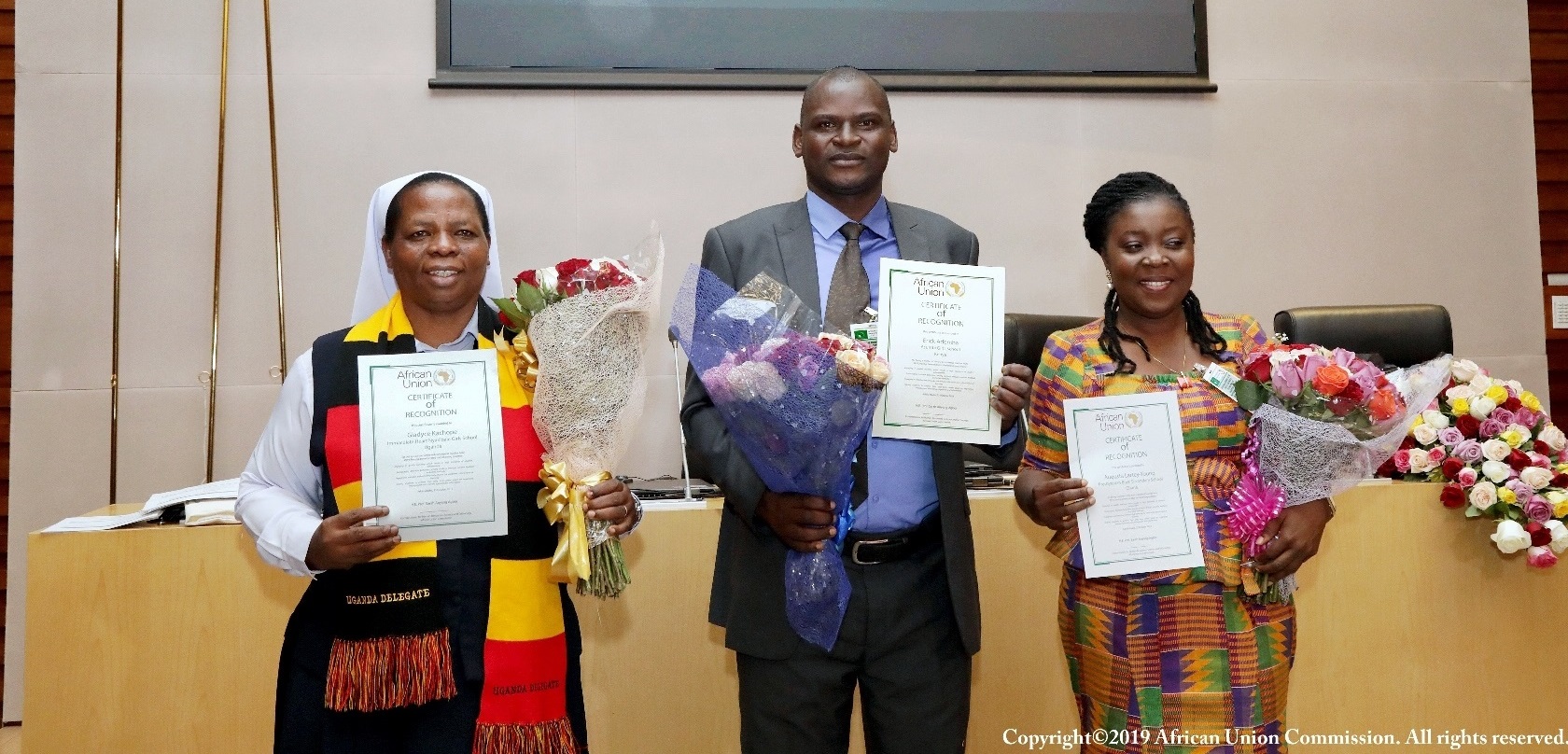
The information provided below was submitted as at 2020-06-08 13:37:51 by the Ministère de l'Education nationale of Senegal in responding to the AU Survey of Member States on Education Sector Response to COVID-19. The information is solely for experience sharing purposes and not to be used for other purposes without express permission of the African Union Commission.
| Country | Senegal |
| Ministry | Ministère de l'Education nationale |
| Education level handled by the Ministry | Pre-School, Primary, Secondary |
| Number of Schools in Pre-School | 3,581 |
| Number of Schools in Primary | 10,343 |
| Number of Schools in Secondary | 1,329 |
| Does the Ministry have a COVID-19 response plan? | No |
| Percentage estimate of Schools Closed | 90-100 |
| Percentage estimate of Schools Offering Distance/Virtual Education | 70-89 |
| Percentage estimate of Students who are currently receiving Virtual/Distance Education | 50-69 |
| Methods for the provision of Distance/Virtual Education | Lessons are scanned and sent through email for students to complete., Interaction through WhatsApp/Telegram or other social messaging applications between students and teachers, Online lessons via government owned e-learning portal, Online lessons via public-private partnership led e-learning portal, TV, Radio |
| Specific Innovations which are being implemented | - La mise en place de duplicopieurs pour la fourniture de fascicules et guide dans les localités non couvertes par les stratégies numériques -documents physiques); - La création d'un canal TNT dédié au télé-enseignement. |
| Partners which are supporting the Ministry of Education to respond to COVID-19 | GPE, Plan International, UNESCO, UNICEF, World Bank, WFP |
| Is there a plan for reopening schools? | Yes |
| Does the reopening plan include a back to School campaign? | Yes |
| Does the reopening plan include catch-up strategies for the school calendar and or curriculum? | Yes |
| Objectives and priorities of the plan to reopen Schools | Les objectifs visés par le plan de réouverture sont: - étudier les scénarii de réouverture en fonction de l'évolution de la pandémie; - assurer une réouverture progressive des classes (une feuille de route du scénario adopté); - coordonner en rapport avec les Ministères concernés, les actions nécessaires pour assurer une ouverture sécurisé des établissements; - définir un protocole sanitaire en rapport avec le Ministère de la santé pour orienter la réouverture des écoles et les condition de séjours des élèves dans les établissements. |
| Is there a separate strategy/strategies for girls to catch up on their education due to the impact of COVID-19? | Yes |
| Challenges that have been encountered by the Ministry while responding to COVID-19 | Availability of Virtual Learning Technology Hardware and Infrastructure, Internet Connectivity to support deployment Virtual Learning platforms, Financing gaps |
| Date Submitted | 08-06-2020 |
If you are interested in contacting the Ministry for further information, please contect This email address is being protected from spambots. You need JavaScript enabled to view it.. Please note that any secondary use of this data is not allowed without seeking express permission of the African Union Commission.

The information provided below was submitted as at 2020-06-08 17:36:04 by the Ministry of Higher Education Research Science and Technology of Gambia in responding to the AU Survey of Member States on Education Sector Response to COVID-19. The information is solely for experience sharing purposes and not to be used for other purposes without express permission of the African Union Commission.
| Country | Gambia |
| Ministry | Ministry of Higher Education Research Science and Technology |
| Education level handled by the Ministry | Tertiary Education, TVET |
| Number of Schools in Tertiary | 26 |
| Number of Schools in TVET | 88 |
| Does the Ministry have a COVID-19 response plan? | Yes |
| Objectives and Priorities of the COVID-19 response plan | Online classes is presently conducted by the University of The Gambia and few other Institutions. |
| Percentage estimate of Schools Closed | 90-100 |
| Percentage estimate of Schools Offering Distance/Virtual Education | 30-49 |
| Percentage estimate of Students who are currently receiving Virtual/Distance Education | 50-69 |
| Methods for the provision of Distance/Virtual Education | Interaction through WhatsApp/Telegram or other social messaging applications between students and teachers, Online lessons via public-private partnership led e-learning portal |
| Specific Innovations which are being implemented | Only the The University of the Gambia is offering distance learning at the moment, however, there are plans to extend this practice to other tertiary Institutions. |
| Partners which are supporting the Ministry of Education to respond to COVID-19 | ADEA, UNESCO, World Bank |
| Is there a plan for reopening schools? | Yes |
| Does the reopening plan include a back to School campaign? | Yes |
| Does the reopening plan include catch-up strategies for the school calendar and or curriculum? | Yes |
| Objectives and priorities of the plan to reopen Schools | In the short term online classes are implemented, later face to face examinations to be strategies for University students, and then final year students in other Institutions will be assisted to graduate, before a final opening of all Institutions, hopefully, in September 2020. |
| Is there a separate strategy/strategies for girls to catch up on their education due to the impact of COVID-19? | No |
| Challenges that have been encountered by the Ministry while responding to COVID-19 | Availability of Virtual Learning Technology Hardware and Infrastructure, Availability of Virtual Learning Software and learning platform, Internet Connectivity to support deployment Virtual Learning platforms |
| Date Submitted | 08-06-2020 |
If you are interested in contacting the Ministry for further information, please contect This email address is being protected from spambots. You need JavaScript enabled to view it.. Please note that any secondary use of this data is not allowed without seeking express permission of the African Union Commission.

The information provided below was submitted as at 2020-05-12 14:48:58 by the Ministry of Basic and Secondary Education ( MoBSE) of Gambia in responding to the AU Survey of Member States on Education Sector Response to COVID-19. The information is solely for experience sharing purposes and not to be used for other purposes without express permission of the African Union Commission.
| Country | Gambia |
| Ministry | Ministry of Basic and Secondary Education ( MoBSE) |
| Education level handled by the Ministry | Pre-School, Primary, Secondary |
| Number of Schools in Pre-School | 1432 |
| Number of Schools in Primary | 1376 |
| Number of Schools in Secondary | 201 |
| Does the Ministry have a COVID-19 response plan? | Yes |
| Objectives and Priorities of the COVID-19 response plan | 1. To ensure that children and their families have access to relevant and timely information on COVID-19 to protect themselves from infection and to reduce the transmission rate within communities. 2. To ensure continuity of learning on a minimal curriculum delivery during the school closure and progressively expand the curriculum coverage using multiple curriculum delivery platforms in the medium to long terms. 3. To enhance recovery from the impact of COVID-19 on the education sector and improve the resilience of the sector to guarantee continuity of learning under any circumstance. 4. To ensure that students living in underprivileged family households are supported with basic food items. |
| Percentage estimate of Schools Closed | 90-100 |
| Percentage estimate of Schools Offering Distance/Virtual Education | 0-9 |
| Percentage estimate of Students who are currently receiving Virtual/Distance Education | 90-100 |
| Methods for the provision of Distance/Virtual Education | Interaction through WhatsApp/Telegram or other social messaging applications between students and teachers, Online lessons via government owned e-learning portal, Online lessons via public-private partnership led e-learning portal, TV, Radio |
| Specific Innovations which are being implemented | We have constituted a large stakeholder Education COVID 19 rapid response team to design strategies meant to meaningfully contained children at home but also help mitigate the impact of loss of contact time as a result of school closure |
| Partners which are supporting the Ministry of Education to respond to COVID-19 | Global Partnership for Education (GPE), United Nations Educational, Scientific and Cultural Organization (UNESCO) , United Nations International Children's Emergency Fund (UNICEF) , World Food Program (WFP). |
| Is there a plan for reopening schools? | Yes |
| Does the reopening plan include a back to School campaign? | Yes |
| Does the reopening plan include catch-up strategies for the school calendar and or curriculum? | Yes |
| Objectives and priorities of the plan to reopen Schools | Schools are fumigated and given all health related treatment before reopening to prevent the risk of contamination. Public engagement campaign to gain parents, teachers and students confidence and willingness to return to school. Ensure that learners are provided with accelerated engagement strategies to help cover the curriculum. |
| Is there a separate strategy/strategies for girls to catch up on their education due to the impact of COVID-19? | No |
| Challenges that have been encountered by the Ministry while responding to COVID-19 | Internet Connectivity to support deployment Virtual Learning platforms, Financing gaps |
| Date Submitted | 12-05-2020 |
If you are interested in contacting the Ministry for further information, please contect This email address is being protected from spambots. You need JavaScript enabled to view it.. Please note that any secondary use of this data is not allowed without seeking express permission of the African Union Commission.

The information provided below was submitted as at 2020-05-10 01:51:35 by the Ministério da Educação of Cape Verde in responding to the AU Survey of Member States on Education Sector Response to COVID-19. The information is solely for experience sharing purposes and not to be used for other purposes without express permission of the African Union Commission.
| Country | Cape Verde |
| Ministry | Ministério da Educação |
| Education level handled by the Ministry | Pre-School, Primary, Secondary |
| Number of Schools in Pre-School | 570 |
| Number of Schools in Primary | 394 |
| Number of Schools in Secondary | 41 |
| Does the Ministry have a COVID-19 response plan? | Yes |
| Objectives and Priorities of the COVID-19 response plan |
O presente Plano de resposta da Educação a curto e médio prazo dos efeitos da COVID-19, tem como principal objetivo apresentar orientações estratégicas e ações para reduzir, minimizar os efeitos da COVID-19 no sentido de garantir a aprendizagem durante o período de crise e ter bases para continuar o processo educativo pós-crise, tirando proveito das inovações introduzidas, de forma sustentável. para reduzir os impactos do COVID-19 no sistema educativo Caboverdiano através da promoção de oportunidade de de aprendizagem durante este período. 4.2.1 Objetivo geral: |
| Percentage estimate of Schools Closed | 90-100 |
| Percentage estimate of Schools Offering Distance/Virtual Education | 90-100 |
| Percentage estimate of Students who are currently receiving Virtual/Distance Education | 90-100 |
| Methods for the provision of Distance/Virtual Education | Lessons are scanned and sent through email for students to complete., Interaction through WhatsApp/Telegram or other social messaging applications between students and teachers, Online lessons via government owned e-learning portal, TV, Radio |
| Specific Innovations which are being implemented | Tele-aulas, uso de plataformas e interação dos docentes com os alunos via redes sociais. |
| Number of Technical and Vocational Education and Training (TVET) Institutions offering Distance-Virtual Education | 4 |
| Partners which are supporting the Ministry of Education to respond to COVID-19 | Global Partnership for Education (GPE), United Nations Educational, Scientific and Cultural Organization (UNESCO) , United Nations International Children's Emergency Fund (UNICEF) , Others (to be provided), Banco Mundial |
| Is there a plan for reopening schools? | Yes |
| Does the reopening plan include a back to School campaign? | Yes |
| Does the reopening plan include catch-up strategies for the school calendar and or curriculum? | Yes |
| Objectives and priorities of the plan to reopen Schools | De acordo com as últimas orientações do Governo as aulas presencias apenas terão lugar no próximo ano letivo, ao seja a partir de 1 de Setembro de 2020. As prioridades é garantir uma maior segurança na preparação do retorno as escolas, entretanto durante este período de interregno as aulas serão pela via de EaD, Tele e áudio aula, e nos casos de zonas sem acesso recorre-se as fichas, sabentas e em caso de possibilidade será feito acompanhamento do aluno em regime presencial, desde que seja comprido as normas de distanciamento e de higienização dos espaços escolas. |
| Is there a separate strategy/strategies for girls to catch up on their education due to the impact of COVID-19? | No |
| Challenges that have been encountered by the Ministry while responding to COVID-19 | Availability of Virtual Learning Technology Hardware and Infrastructure, Internet Connectivity to support deployment Virtual Learning platforms, Technical capacity gaps for Virtual/Distance Education Support Personnel, Financing gaps. |
| Date Submitted | 10-05-2020 |
If you are interested in contacting the Ministry for further information, please contect This email address is being protected from spambots. You need JavaScript enabled to view it.. Please note that any secondary use of this data is not allowed without seeking express permission of the African Union Commission.

The information provided below was submitted as at 2020-05-19 16:03:53 by the Ministry of Technical and Higher Education of Sierra Leone in responding to the AU Survey of Member States on Education Sector Response to COVID-19. The information is solely for experience sharing purposes and not to be used for other purposes without express permission of the African Union Commission.
| Country | Sierra Leone |
| Ministry | Ministry of Technical and Higher Education |
| Education level handled by the Ministry | Tertiary Education, TVET |
| Number of Schools in Tertiary | 7 |
| Number of Schools in TVET | 194 |
| Does the Ministry have a COVID-19 response plan? | Yes |
| Objectives and Priorities of the COVID-19 response plan |
The purpose of our Plan is to prepare, respond and utilize critical resources to address the COVID-19 outbreak. In line with the global health approach and as indicated in our national approach, the MTHE has developed this preparedness and response framework, which would: Additionally, we will: |
| Percentage estimate of Schools Closed | 90-100 |
| Percentage estimate of Schools Offering Distance/Virtual Education | 0-9 |
| Percentage estimate of Students who are currently receiving Virtual/Distance Education | 10-29 |
| Methods for the provision of Distance/Virtual Education | Lessons are scanned and sent through email for students to complete., Interaction through WhatsApp/Telegram or other social messaging applications between students and teachers, Online lessons via government owned e-learning portal |
| Specific Innovations which are being implemented | Since students are home, our colleges and TVET centers are getting assignments from the list above, however, our innovative way to transmit learning is by: 1. select core and some hard courses, especially in TVET, develop lesson notes, film intructors while teaching, edit and burn the items in a fflash drive and share to TVET centers for onward distribution to students with computes or device with ubs port. For those without, the TVET administrators are negotiating the possibilities to have 10 students at a time in a well spaced room, and following all the health protocols to access the materials |
| Number of Technical and Vocational Education and Training (TVET) Institutions offering Distance-Virtual Education | 13 |
| Partners which are supporting the Ministry of Education to respond to COVID-19 | World Bank |
| Is there a plan for reopening schools? | Yes |
| Does the reopening plan include a back to School campaign? | Yes |
| Does the reopening plan include catch-up strategies for the school calendar and or curriculum? | Yes |
| Objectives and priorities of the plan to reopen Schools |
Part of our recovery strategy is to reopen school when the covid19 would have been brought under control. The objective is to limit the damage done by EBOLA and now COVID19 to catchup with other West African countries. We are planning to start reopening with the TVET centers, they have smaller number and later the universities and colleges |
| Is there a separate strategy/strategies for girls to catch up on their education due to the impact of COVID-19? | No |
| Challenges that have been encountered by the Ministry while responding to COVID-19 | Availability of Virtual Learning Technology Hardware and Infrastructure, Internet Connectivity to support deployment Virtual Learning platforms, Technical capacity gaps for Virtual/Distance Education Support Personnel, Financing gaps. |
| Date Submitted | 19-05-2020 |
If you are interested in contacting the Ministry for further information, please contect This email address is being protected from spambots. You need JavaScript enabled to view it.. Please note that any secondary use of this data is not allowed without seeking express permission of the African Union Commission.
Page 2 of 3

















